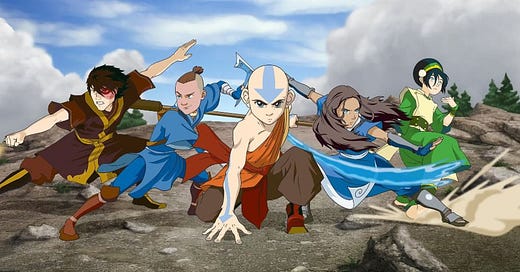Marcia’s Identity Theory and Avatar the Last Airbender: Using Characters to Understand the Theory’s Categories
Because what better way to understand an identity theory than with a kids show?
As I’ve gone through my educational journey, I’ve found that the way I watch TV or movies is with a much more analytical lens. After my undergraduate experience, I was watching movies with the lens of a writer and commenting on choices the writers made throughout the film. After grad school, I was looking at characters through the lens of student development theories. So if you’ll include me for a moment, today I want to explore James Marcia’s Identity Theory (Marica’s Matrix) and the main characters of Avatar the Last Airbender.
Now, before I go off about the movie (which wasn’t good) or the new Netflix adaptation (which was much better, but I have some thoughts) I think it’s important to talk about what Marcia’s Identity theory entails. Usually this theory is applied to university students and their development during their time in college. I learned that, especially during college, our identity tends to shift and change as we explore who we are and what it is that we want.
Now the matrix is pretty simple and it looks like this:
Now the main thing to note about the theory is that it looks at 1) if a person has explored all their options, interests, passions etc. and 2) if a person has committed to one of those things. Each section is defined below.
Identity diffusion: (low exploration, low commitment) a person in this category has not considered their identity, and tends to be pretty reactive to life and the things happening around him
Identity Moratorium: (exploration, but no commitment) a person in this category is exploring different identities and values and goals without making a commitment. They are still determining what is important to them.
Foreclosure: (no exploration, but commitment to an identity) a person in this category has committed to an identity but has not looked at alternatives or investigated the values and beliefs that they have been taught
Identity Achievement: (exploration and commitment) in this category a person has actively explored the values and identities that they would like to align themselves with and are committed to them
So keeping these in mind, I’d like to take a look at the characters from the original Avatar the Last Airbender cartoon. Because as much as I did like the Netflix version of the show, I think that there is a lot more to be gleaned from the cartoon.
Starting off with Aang/the Avatar represents Foreclosure. While Aang has committed to his identity of being the Avatar, he hasn’t explored what this means for him, his goals, or his values. Early on, we see Aang constantly struggle with his identity of being the Avatar and this, I think, is such a reflection of being in the foreclosure category. Through this series, he learns what being the Avatar means to him and what his goals are. By the end of the series, we see him reach identity achievement.
Moving onto Sokka, I believe that he falls into the Identity diffusion section. While Sokka knows that he is a warrior and seems to lead the group on their journey, Sokka finally addresses that he has not really had any one to help him become the best warrior in Season 3. Throughout their journey, Sokka compares himself to his dad and other leaders and only seeing his own weaknesses. He also tends to react to the situations that the group finds themselves in. So while he may be a warrior, he isn’t the leader that he could be. I think after his time with the sword master, Sokka emerges a much stronger warrior and reaches identity achievement.
Next, I think that Katara, especially in the first season, represents the Identity Moratorium category. While Katara knows that she is a water bender, she doesn’t quite commit to the identity of being a strong water bender until she leaves the Northern Water Tribe. In the first season, she and Aang are constantly finding ways to learn about water bending and training on their own. Katara sees the mastery outside of herself this first season and is open to learning as much as she can. Once we reach the end of the first season, I think Katara finally sees herself as a water bender and a master.
Lastly, Toph is a clear example of identity achievement. Toph has explored the identities and values that she was born into and the ones she found through her own journey eventually leading her to commit to who she is as a person. When the group finally meets Toph, we can see what a strong character she is and how her own exploration has made her who she is. Her identity doesn’t change when we see her with the group and this really helps the others in their own pursuit of finding their identity.
I love the this show so much and I think it’s so much fun to see how it relates to the theory I learned in school. Thanks for allowing me to nerd out for just a moment. Let me know if there are other shows or characters that you can think of that fall into Marcia’s Matrix.





